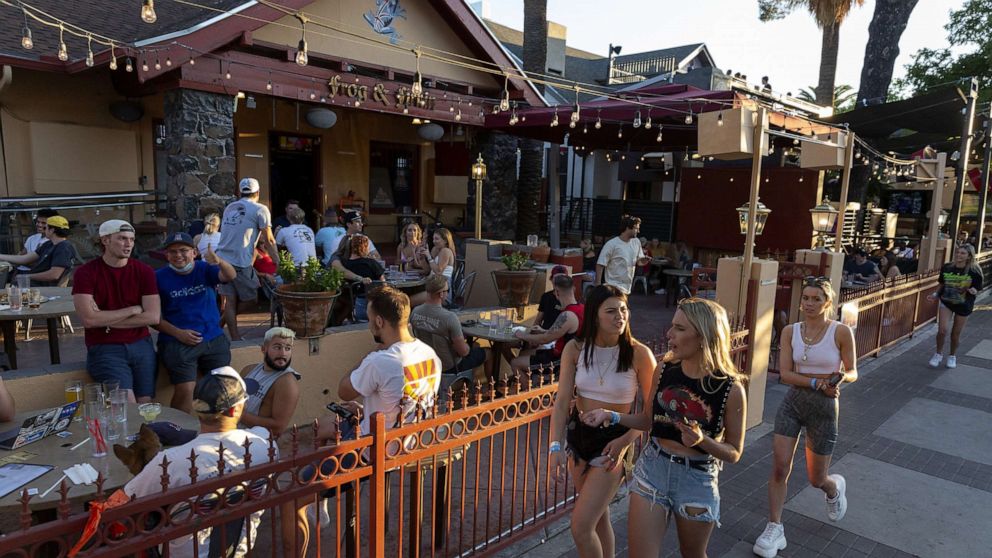The American Way vs The Canadian Way
"We do see all of these kinds of trends as a warning signal for us again, reminding Canadians the virus is still around, very much around in many parts of the world including the United States."
"We need to keep up and the moment we let go, this virus could find some way of accelerating in our community."
Dr.Theresa Tam, Canada's Chief Public Health Officer
"We saw a preview of what not to do in the United States is not just wait until you get a peak, let the cases drop a little bit and then open the door."
"Moving slower is probably a whole lot better than moving faster, as we're seeing in the United States."
"We're opening the door much later into our downward curve. We're doing it regionally. We're doing it much more thoughtfully."
Dr.Zain Chagla, specialist in infectious disease, assistant professor, McMaster University
"It's probably some combination of poor policy that doesn't take into account how contagious this is, re-opening economies and lifting public health restrictions too early; people not adhering to existing public health guidelines; and then factor in barriers to health care, as well might be exacerbating numbers."
"Many parts of the United States have politicized the pandemic and politicized the public health interventions, have politicized mask wearing, and they've done themselves a tremendous disservice by doing so."
"Albert lifted public health restrictions, leaving behind Calgary and Brooks; Quebec lifted public health restrictions leaving behind Montreal and the surrounding areas; Ontario lifted public health restrictions leaving behind parts of the Greater Toronto Area."
"Lifting public health restrictions is not a one-way street. They might need to be reimposed if there's a large number of cases in a particular area."
Dr.Isaac Bogoch, infectious disease specialist, Toronto General Hospital Research Institute / University of Toronto
 |
A waiter at Raku, an
Asian restaurant in Bethesda, wears a protective face mask as serve
customers outdoors amid the coronavirus pandemic on June 12, 2020 in
Bethesda, Maryland.
Sarah Silbiger | Getty Images
|
Many of these businesses were so eager to give the impression that nothing has changed, that it's back to normal times, and nothing to be concerned about, that they eschewed distancing requirements since after all, to recognize them would be to allow fewer patrons to enter their premises. And, as Canada's chief public health officer pointed out, failure to maintain standards related to handwashing and social distancing would be certain to cause a new infection surge. No one's perfect, however, and as Canada's premier authority advising government, she failed to endorse face masks until lately.
In Canada, provincial and federal governments agreed their best practise would reflect a mutually- agreed set of guidelines to launch re-openings that would require before proceeding, an actual downward trend of infections, along with contact tracing and testing to be widely available. On the other hand, the U.S. claims that it has tested a greater number of people than any other country has managed to do. With the president sagely advising that less testing would result in fewer cases.
 |
| Pedestrians walk past customers sitting outside at a bar in Tucson, Arizona, May 11, 2020. Cheney Orr/Bloomberg via Getty Images |
Georgia, seeing a surge in cases, was one of the first to open its economy toward the end of April. On April 24, the day businesses opened, no new cases were reported. A month later 946 cases surfaced, and Friday's numbers were hiked up to 1,800 novel coronavirus cases. Reopening efforts began in early May for Florida, Arizona, California and Texas and those states too now see a rise in daily case counts two or three times higher than at any point in the pandemic.
The worst-hit provinces in Canada -- Quebec and Ontario -- initiated their opening phase regionally and gradually. Toronto and Montreal, the cities which were hit particularly hard, retain many restrictions in view of their high rate of COVID. In Ontario 174 new cases were seen on Sunday, to Montreal's 92. The greater Toronto area has a population of over 6 million, while Montreal's stands at just over 4 million, to place numbers in perspective.
So, as Dr. Chaglia pointed out, Canadian provinces chose to move from complete lockdown to re-openings of a gradual nature, giving them the opportunity to address new outbreaks and clusters before they might spread; a thoughtful mechanism for control. Canadians, for that matter, tend to follow regulations somewhat more carefully than do Americans, though both chafe at the restrictions to their freedoms.
Experts in Canada on the novel coronavirus feel U.S. COVID numbers should act a a sign to the Canadian government to continue to maintain and to extend closed borders. Which may very well result in yet another extension of the border closure between Canada and its southern neighbour to all but essential travel beyond the current date of July 21.

Labels: Canada, COVID Case Surges, Gradual Re-Opening, Novel Coronavirus, Re-Opening, United States. Lockdown
0 Comments:
Post a Comment
<< Home